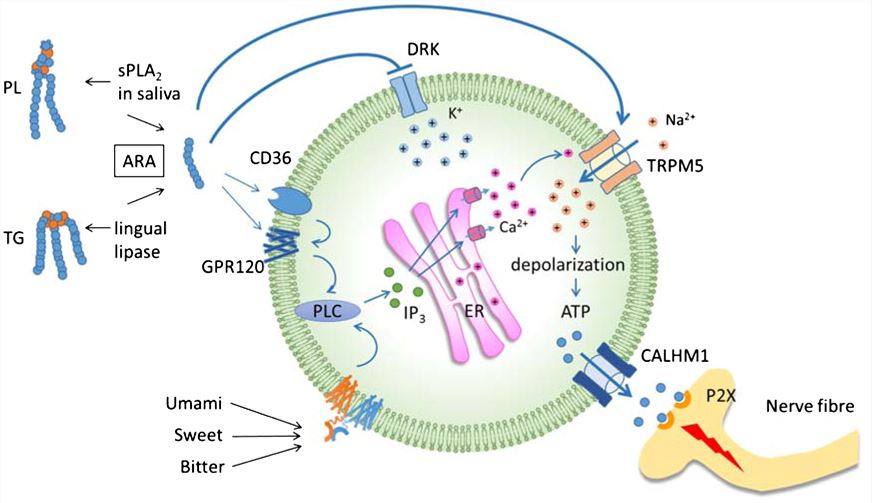Introduction of CALHM1
CALHM1 (calcium homeostasis regulator 1) is a cell surface calcium channel expressed in brain neurons that controls intracellular calcium signaling and cell excitability, the two mechanisms required for synaptic function. CALHM1 forms a plasma membrane ion channel that mediates neuronal excitability in response to changes in extracellular Ca2+ concentration. The CALHM1 channel is a hexamer consisting of six monomers, each having four transmembrane domains, a cytoplasmic amino and carboxy terminus, an amino-terminal helix, and a conserved extracellular cysteine. The CALHM1 channel has an estimated pore size of ~14Å and is capable of penetrating large charged molecules.
| Basic Information of CALHM1 | |
| Protein Name | Calcium homeostasis modulator protein 1 |
| Gene Name | CALHM1 |
| Aliases | Protein FAM26C |
| Organism | Homo sapiens (Human) |
| UniProt ID | Q8IU99 |
| Transmembrane Times | 4 |
| Length (aa) | 346 |
| Sequence | MMDKFRMIFQFLQSNQESFMNGICGIMALASAQMYSAFDFNCPCLPGYNAAYSAGILLAPPLVLFLLGLVMNNNVSMLAEEWKRPLGRRAKDPAVLRYMFCSMAQRALIAPVVWVAVTLLDGKCFLCAFCTAVPVSALGNGSLAPGLPAPELARLLARVPCPEIYDGDWLLAREVAVRYLRCISQALGWSFVLLTTLLAFVVRSVRPCFTQAAFLKSKYWSHYIDIERKLFDETCTEHAKAFAKVCIQQFFEAMNHDLELGHTHGTLATAPASAAAPTTPDGAEEEREKLRGITDQGTMNRLLTSWHKCKPPLRLGQEEPPLMGNGWAGGGPRPPRKEVATYFSKV |
Function of CALHM1 Membrane Protein
CALHM1 is a pore-forming subunit of voltage-gated ion channels for the perception of sweetness, bitterness and umami taste, especially in type II taste bud cells, which are sweet, bitter and fresh by inducing ATP release from cells. It acts as a voltage-gated and calcium-activated ion channel: it responds to changes in extracellular Ca2+ concentration that mediates neuronal excitability. It also mediates the penetration of Ca2+, Na+, and K+, as well as the penetration of monovalent anions, and acts as an activator of the ERK1 and ERK2 cascades, which triggers endoplasmic reticulum stress by reducing the calcium content of the endoplasmic reticulum.
 Fig.1 Proposed signaling pathway in type II receptor cells. (Shigeyuki, 2017)
Fig.1 Proposed signaling pathway in type II receptor cells. (Shigeyuki, 2017)
Application of CALHM1 Membrane Protein in Literature
This article reports that the mutated form of Ca2+ channel CALHM1 (Ca2+ homeostasis regulator 1), P86L-CALHM1, is related to the early onset of Alzheimer's disease (AD).
This article reveals that activation of CALHM1 promotes phosphorylation of NMDA and AMPA receptors by protein kinase A, and activation of neuronal CALHM1 enhances the effects of glutamate on c-Fos and C/EBPβ expression, two immediate-early gene marker of neuronal activity. CALHM1 controls synaptic activity in brain neurons and is involved in the flexible processing of mouse memory.
This article indicates that CALHM1 is involved in the formation of plasma membrane ion channels, which are sensitive to changes in extracellular Ca2+ concentration, thereby mediating neuronal excitability.
This article shows that CALHM1 is an essential ion channel component of ATP neurotransmitter release mechanism in type II taste bud cells. Type II taste bud cells stimulate action potentials in response to tastants and trigger non-cystic ATP release to taste neurons via voltage-gated CALHM1-related ion channels.
This article evaluates that CALHM1 promotes neuronal and Ca2+-dependent degradation of extracellular Aβ by insulin degrading enzymes (IDE) to control Aβ levels in cell lines and in vivo. Therefore, we can use the CALHM1 ion channel as a potential target for promoting amyloid clearance in AD.
CALHM1 Preparation Options
To obtain the soluble and functional target protein, the versatile Magic™ membrane protein production platform in Creative Biolabs enables many flexible options, from which you can always find a better match for your particular project. Aided by our versatile Magic™ anti-membrane protein antibody discovery platform, we also provide customized anti-CALHM1 antibody development services.
As a forward-looking research institute as well as a leading customer service provider in the field of membrane protein, Creative Biolabs has won good reputation among our worldwide customers for successfully accomplishing numerous challenging projects including generation of many functional membrane proteins. Please feel free to contact us for more information.
Reference
All listed services and products are For Research Use Only. Do Not use in any diagnostic or therapeutic applications.